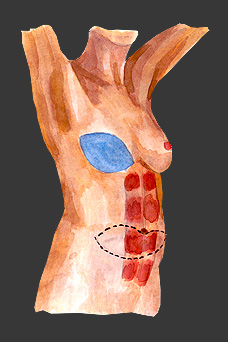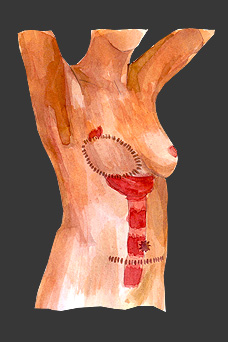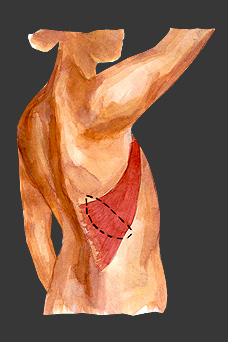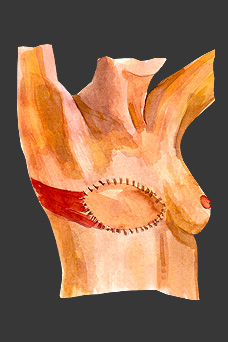Facial surgery
Breast surgery
Breast reconstruction
Other operations
Non-surgical procedures
Breast reconstruction
Breast reconstruction is performed for women who have lost their breasts due to breast cancer or other diseases, or for those who have congenital deformities of their breasts. During this operation attempts are made not only to form a new breast but also to return self-confidence, alleviate emotional discomfort and to increase the quality of life of the patient. Successfully restored breasts may look and feel quite natural but unfortunately they will never be the same as they were prior to mastectomy. It is advisable to consult a plastic surgeon before the breast is removed in order to improve the results of breast reconstruction, because in some cases it is possible to restore the breast during the mastectomy procedure.
Procedure
Breast reconstruction is a highly individualised procedure, depending not only on the patient’s physical form, anatomical features, expectations of surgery, and the extent of breast removal, but also, in the case of cancer, on the stage of the disease, further cancer treatment, and various other risk factors. In general a new breast can be formed either by using autologous tissues from the same patient, or by using synthetic implants.
Some of the most common methods of breast reconstruction using autologous tissues are myocutaneous flaps, such as the transversal rectal abdominal myocutaneous flap (TRAM flap). In this procedure a new breast is formed from the skin and subcutaneous tissue taken from the anterior abdominal wall. This technique is quite popular due to its successful aesthetic results. The anterior abdominal wall has enough subcutaneous tissue to form a breast, and an abdominoplasty is performed during the same operation.
Currently, increasingly positive results are being achieved using the patients’ own fat cells for breast reconstruction. Fat cells are taken with a special cannula using negative pressure. Subsequently, the fat cells are carefully prepared for transplantation: washed and separated from tissue fluid. The prepared fat graft is injected into the breast stump, spreading it evenly throughout the subcutaneous tissue and muscles. During one procedure 100-300 cc of adipose tissue can be injected. Still, fat grafting is more suitable as an auxiliary procedure, adjusting the shape or volume of the breast after reconstruction has been achieved with other method, or in such cases where only a part of the breast is removed.
It is also possible to restore breasts with implants. In this case one can select the desirable volume and shape of the implant. If there is insufficient tissue to accommodate the desired implant, a tissue expander is inserted before the final placement of the implant. The expander is gradually inflated with a special solution until it forms a proper "pocket" for the implant, at which point it is replaced. The entire reconstruction process can take about 4-6 months or even longer, but the procedures are usually well tolerated.
It is important to know that whatever choice of breast reconstruction technique is made, a single procedure will not be enough to achieve good results. Often additional procedures such as adjustments of the breast shape, areola and nipple reconstruction, or reduction of the opposite breast need to be undertaken, until eventually the patient is satisfied with the results. It is important to note that, even after additional procedures and operations, the desired results cannot always be achieved.
Procedure
Breast reconstruction is a highly individualised procedure, depending not only on the patient’s physical form, anatomical features, expectations of surgery, and the extent of breast removal, but also, in the case of cancer, on the stage of the disease, further cancer treatment, and various other risk factors. In general a new breast can be formed either by using autologous tissues from the same patient, or by using synthetic implants.
Some of the most common methods of breast reconstruction using autologous tissues are myocutaneous flaps, such as the transversal rectal abdominal myocutaneous flap (TRAM flap). In this procedure a new breast is formed from the skin and subcutaneous tissue taken from the anterior abdominal wall. This technique is quite popular due to its successful aesthetic results. The anterior abdominal wall has enough subcutaneous tissue to form a breast, and an abdominoplasty is performed during the same operation.
Currently, increasingly positive results are being achieved using the patients’ own fat cells for breast reconstruction. Fat cells are taken with a special cannula using negative pressure. Subsequently, the fat cells are carefully prepared for transplantation: washed and separated from tissue fluid. The prepared fat graft is injected into the breast stump, spreading it evenly throughout the subcutaneous tissue and muscles. During one procedure 100-300 cc of adipose tissue can be injected. Still, fat grafting is more suitable as an auxiliary procedure, adjusting the shape or volume of the breast after reconstruction has been achieved with other method, or in such cases where only a part of the breast is removed.
It is also possible to restore breasts with implants. In this case one can select the desirable volume and shape of the implant. If there is insufficient tissue to accommodate the desired implant, a tissue expander is inserted before the final placement of the implant. The expander is gradually inflated with a special solution until it forms a proper "pocket" for the implant, at which point it is replaced. The entire reconstruction process can take about 4-6 months or even longer, but the procedures are usually well tolerated.
It is important to know that whatever choice of breast reconstruction technique is made, a single procedure will not be enough to achieve good results. Often additional procedures such as adjustments of the breast shape, areola and nipple reconstruction, or reduction of the opposite breast need to be undertaken, until eventually the patient is satisfied with the results. It is important to note that, even after additional procedures and operations, the desired results cannot always be achieved.
| Breast reconstruction using abdominal tissue (TRAM flap) | ||||
 |
 |
|||
| Donor site | Abdominal tissue grafted with muscle pedicle | |||
| Breast reconstruction using dorsal tissue (LDM flap) | ||||
 |
 |
|||
| Donor site | Dorsal tissue grafted with muscle pedicle | |||
Breast reconstruction, like any other intervention, can have adverse effects that should be discussed with the plastic surgeon during the consultation process.
Postoperative period
The postoperative period is highly individual and will depend on the breast reduction method chosen. Considerations should be discussed during the consultation.
| Tautrimas Aštrauskas - Certified Plastic & Reconstructive Surgeon www.blossomandjasmine.com |
 |
 |
 |
solution: inverse.lt |
